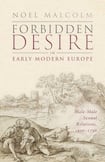
Unearthing the history of sexuality is both vitally important and incredibly difficult. It is significant because most people have an interest – if not a stake – in what is possible and permissible, then and now, and hard to determine because not all that many of us broadcast what we do in private with others. Accordingly, historians of sexuality have to rely on court records, decrees, polemics, sermons, literary works, and other fragmentary pieces of evidence, especially when dealing with societies where few personal letters and diaries survive.
Noel Malcolm’s magnificently researched and gripping new book uses a vast cache of such evidence to rethink the nature of male same-sex relations from the end of the Middle Ages to the dawn of the Enlightenment. The book opens with a scandalous story of ill-concealed male-male sexual relations in the Venetian embassy in Istanbul in 1588, one that threatened to undermine Christian assumptions of religious and cultural superiority to their Islamic hosts, by revealing that Italians enjoyed sodomy as much as their hosts.
What emerges is a story of complicated geographical divisions that have all too often been conflated to tell a single story. In the Ottoman Empire and southern Europe, same-sex male relations were permitted, even celebrated, so long as they involved an older man and a beautiful boy, probably more so below the Mediterranean, but certainly in many European locations, such as Florence. What was not acceptable was an older man who assumed the role of a passive partner, or a relationship between men of the same age.
In northern Europe there was little enthusiasm for such pederasty, and same-sex male relations when they took place invariably involved equal partners. Prof Malcolm has little time for those who have claimed to uncover a coherent subculture of effeminacy or semi-legalised homosexual brothels in England, France or the Netherlands. Nor for arguments that there was an abrupt change in the culture of male same-sexuality after 1700, so that people no longer thought of acts such as sodomy that might be committed, but sodomites or homosexuals. There have always been people who knew that they preferred one sex to the other, such as the English diplomat and spy, Anthony Bacon, or the Italian artist, Giovanni Antonio Bazzi, who went by the name “Sodoma”, but, in some societies, that love did not dare speak its name.










